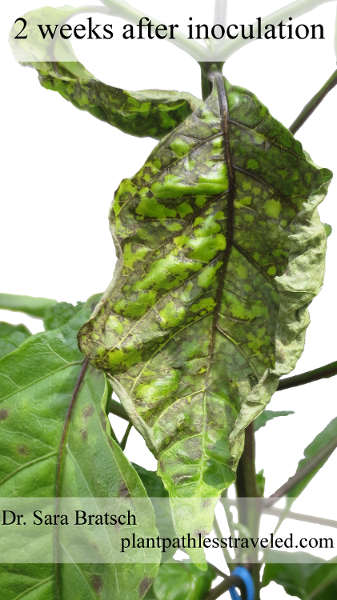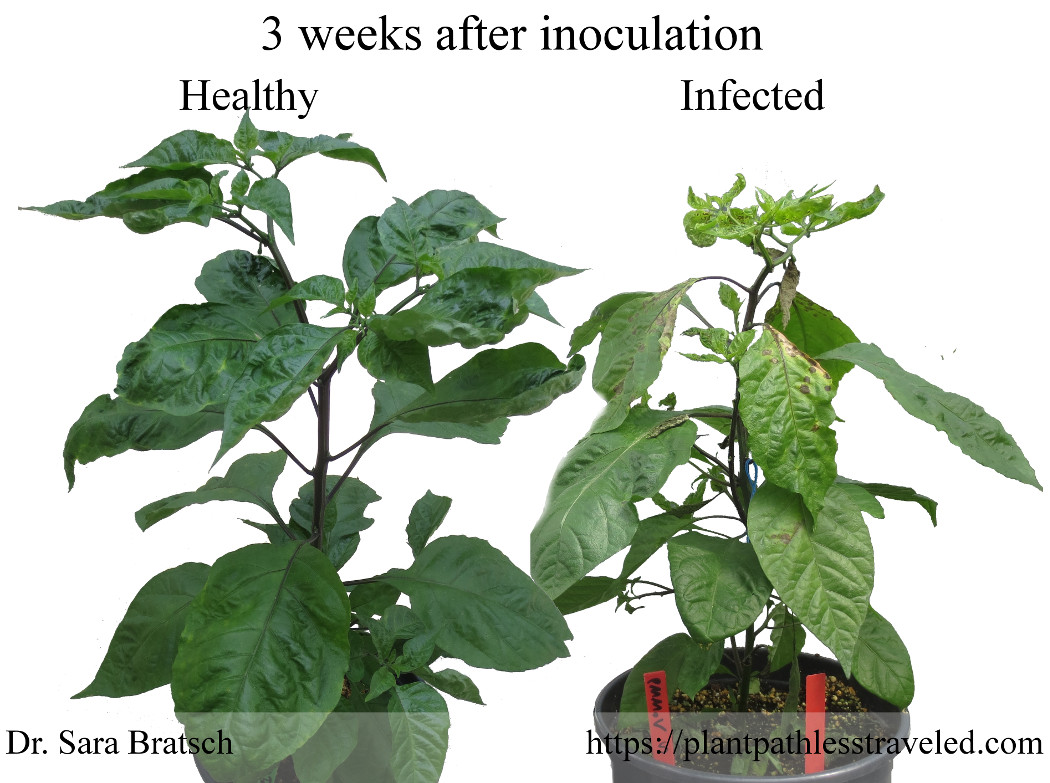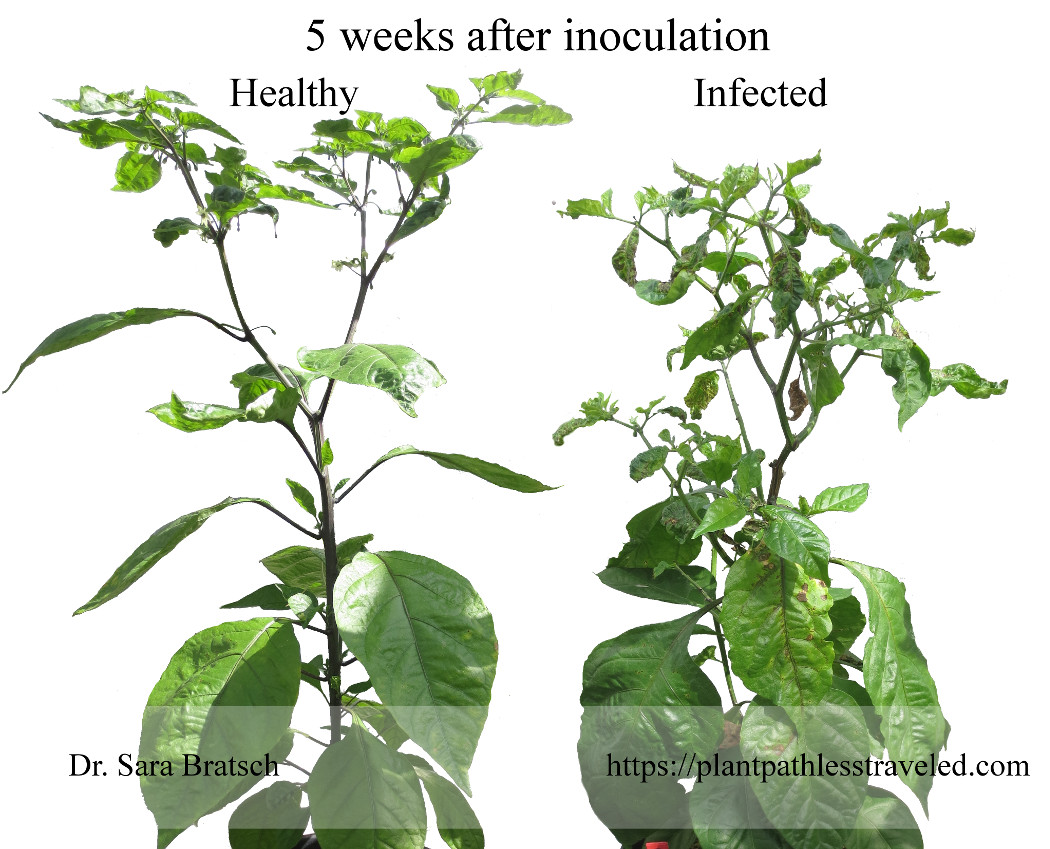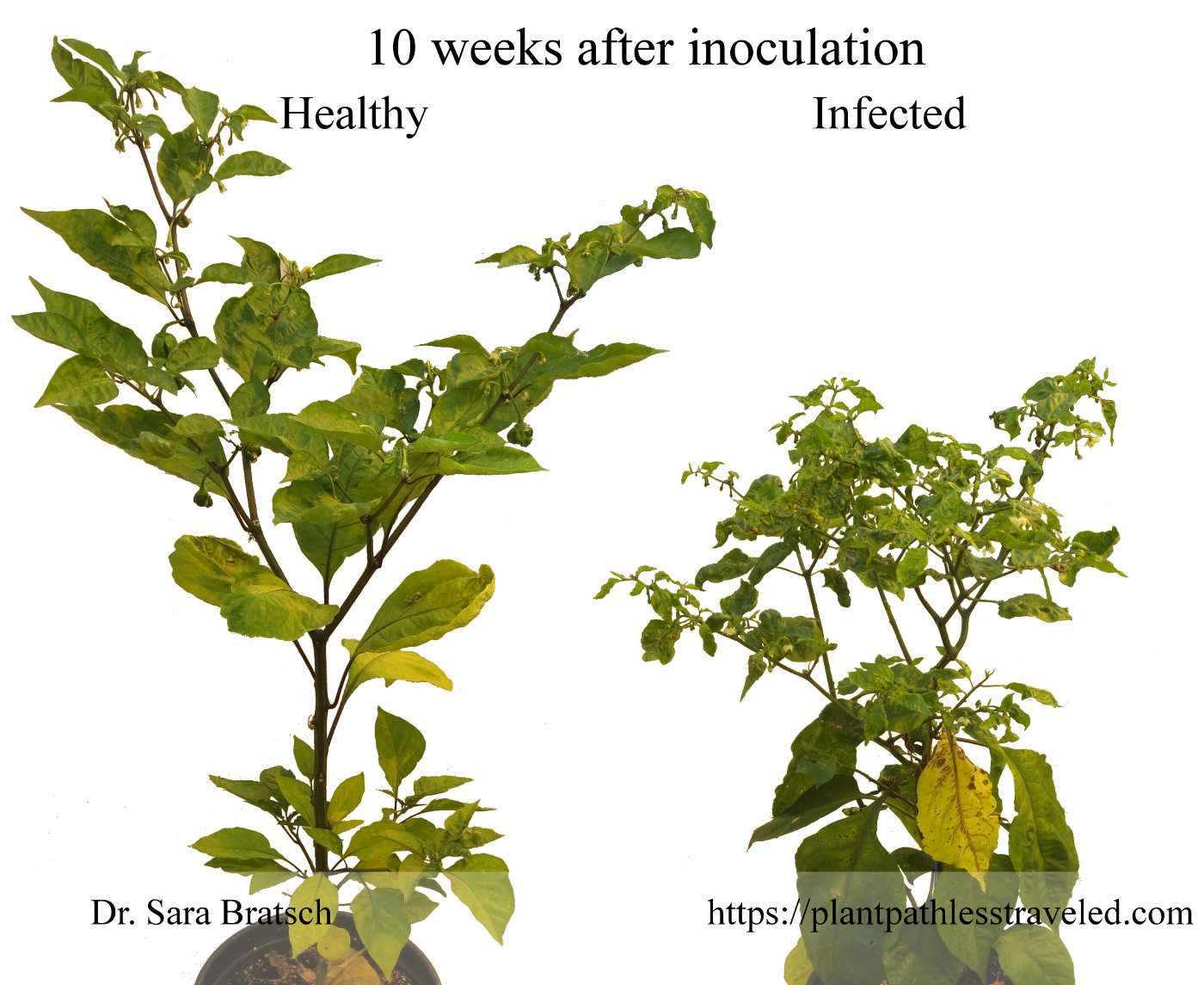Pepper mild mottle virus
By: Dr. Sara Bratsch
This is an article containing relevant information for pepper growers about Pepper mild mottle virus (abbreviated PMMoV).
For a .pdf version of this article, please click here.
Plants Pepper mild mottle virus (PMMoV) can infect 3, 11
- Sweet and chilli peppers, Capsicum annuum
- Cayenne pepper, C. baccatum
- Hot bonnet peppers, C. chinense
- Tabasco or cayenne peppers, C. frutescens
- Most other domesticated or wild capsicum species
- Petunia, Petunia hybrida (asymptomatic)
- Basil, Ocimum basilicum L. (local lesions)
- Plants of mainly academic/research interest including: tobacco varieties (Nicotiana clevelandii Gray, N. debneyi, N. glutinosa, N. sylvestris, N. tabacum); Datura metel, D. stramonium, Chenopodium amaranticolor, C. quinoa
Plants PMMoV cannot infect: 3, 4
- Tomato, Solanum lycopersicum L.
- Eggplant/aubergine/brinjal, Solanum melongena L.
- Cucumber, Cucumis sativus
- Beans, Phaseolus vulagris
- Many others
Symptoms in peppers 1, 3, 4, 7, 11
Symptoms will vary depending upon pepper variety, virus isolate, plant age when infected, and environmental conditions. Symptom pictures of PMMoV in Carolina Reaper peppers can be found below.
Leaf symptoms:
- Mild mottle
- Mosaic (light and dark yellow or green patches) can appear 3+ weeks after infection in new apical leaves
- Necrosis (browning)
- Minor or no symptoms
- Stunting
Fruit symptoms:
- Deformed and irregular shapes
- Sunken yellow or white spots and stripes
- Premature flower and fruit abscission leading to no fruit development
PMMoV symptoms in Capsicum chinense ‘Carolina Reaper’
Note: symptoms will vary depending on numerous factors and your plants may not show these exact symptoms.
 Only 4 leaves on the entire plant are showing symptoms at 2 weeks after inoculation, pictured are the most severe symptoms of a brown (necrotic) leaf pattern. This leaf falls off by the following week but you can track the lower left leaf through 10 weeks in the photos that follow.
Only 4 leaves on the entire plant are showing symptoms at 2 weeks after inoculation, pictured are the most severe symptoms of a brown (necrotic) leaf pattern. This leaf falls off by the following week but you can track the lower left leaf through 10 weeks in the photos that follow.
 Inoculated plant has an increase in the number of leaves with brown patterns and some drop off the plant.
Inoculated plant has an increase in the number of leaves with brown patterns and some drop off the plant.
 Healthy plant is growing rapidly and has numerous flowers and fruit set.
Healthy plant is growing rapidly and has numerous flowers and fruit set.
PMMoV inoculated plant has foliar symptoms of mottling and necrotic (brown) patterns in new growth and is stunted. Flower buds are just starting to appear.
 Healthy plant has several ~1" diameter fruit and numerous smaller fruit.
Healthy plant has several ~1" diameter fruit and numerous smaller fruit.
PMMoV inoculated plant is stunted, leaves are mottled and have extensive necrotic patterns. Leaves and flowers fall off and there are no fruit of any size on the infected plant.
Note yellow tone due to HPS lighting.
Yield impact
PMMoV causes high losses because plants infected by PMMoV are often stunted and if any fruit are produced they are not saleable due to their irregular shape and color. In 2002 jalapeno peppers in Georgia, USA were infected by PMMoV which resulted in a yield loss of 50-100%.7
PMMoV is distributed world-wide and can be difficult to detect early due to minor leaf symptoms.4 Producers of transplants should be aware of PMMoV because it is easily transmitted by infected sap and can rapidly infect an entire bench of pepper transplants if preventative cultural control methods are not practiced.
Transmission and spread of PMMoV
PMMoV can be transmitted through infected sap spread from an infected plant to healthy plants during: grafting, transplanting, pruning, trellising, or harvesting.
PMMoV is efficiently transmitted by seed with up to 100% seed infection rates.5 Although some seed lots may be heavily infested with PMMoV, even a low seed transmission rate is enough to start an epidemic if preventative cultural control methods are not practiced.
Detection
PMMoV can be tested for on the farm by using rapid immunochromatographic dipsticks obtained online from commercial sellers or plant leaves or seeds can be mailed or dropped off at a plant disease diagnostic clinic.
Control
The most effective control method for PMMoV is to use preventative control measures to prevent PMMoV from infecting plants because there are no curative chemicals for viral infections in plants.
Seed control of PMMoV 5, 9
Seeds without a coating can be disinfected using 2% lye (sodium hydroxide or caustic soda; NaOH) for 2 minutes at room temperature (~68°F)10 or with 10% trisodium phosphate (Na3PO4) for 2.5 hours at room temperature.
Both treatments should be mixed during soaking and then rinsed thoroughly with tap water and sown immediately. These treatments may reduce germination and increase the number of abnormal seedlings so it is best to test a portion of your seed lot with these treatments to determine if any effects occur with your specific variety.5
These chemical seed treatments will greatly reduce the amount of PMMoV on infested seeds but may not completely eliminate it on heavily infested seeds. These treatments will also eliminate other seed borne viral pathogens.9
Tool sterilization to prevent the spread of PMMoV 6, 8
Tools and glove covered hands can be sterilized by dipping in a 10% solution of bleach (use bleach with a 5.25-6% NaOCl concentration and change the solution frequently, minimally every 2 hours) or 2% Virkon S solution between each plant or variety. Disinfection is immediate, no tool soaking is required. It is recommended to dry tools and hands before handling plants as the chemicals may damage plant tissue. Sap residue must be removed from tools as it can harbor infectious virus, even after a dip. These treatments also prevent transmission of other viruses and plant pathogens.
String used for trellising should not be reused. If wire must be used again, sterilize it by completely submerging in a 5% solution of trisodium phosphate (Na3PO4) for 10 minutes, or 0.1% caustic soda (also called lye and sodium hydroxide with a chemical formula of NaOH) for 10 minutes, or use dry heat (oven) of a minimum of 266° F (130° C) for 15 minutes.
Plant resistance to control PMMoV 2
Resistant pepper varieties could be selected for use in the following years if PMMoV has been diagnosed-however there have been resistance breaking PMMoV strains identified that can infect and cause symptoms in peppers containing resistance genes. These four genes are called the L1-4 resistance genes and were identified from wild capsicum species. There have been no large trials to test the resistance claims that are made for pepper varieties but Cornell University has one of the most complete disease resistance charts for varieties currently on the market that can be used to choose resistant varieties.
Link here: http://vegetablemdonline.ppath.cornell.edu/Tables/TableList.htm
Look-alikes
Other viruses cause similar symptoms to PMMoV but have different hosts and management methods. Testing and identification of the agent causing symptoms will allow for effective management solutions to be taken to reduce damage in the current growing season and the following ones as well. Mixed infections with more than one virus species present are also possible and can be identified by testing symptomatic plants.
Reference to commercial products or trade names is made with the understanding that no discrimination is intended of those not mentioned and no endorsement is implied for those mentioned.
This work was supported by the USDA NIFA AFRI ELI project award#: 2017-67012-26090.
This article was written for that project to inform and educate pepper growers on how to recognize, detect, and manage Pepper mild mottle virus in peppers.
All photos taken by Sara Bratsch. For non commercial use only.
Please contact regarding all other uses including but not limited to: data for computational algorithms, books, pamphlets, articles, apps, websites, etc.
Cite this article:
Bratsch, Sara. 2018. "Pepper mild mottle virus". Web article. (date accessed). http://plantpathlesstraveled.com/pepper-mild-mottle-virus
Citations
- Adkins, S., Lamb, E. M., Roberts, P. D., Gooch, M. D., Breman, L., and Shuler, K. D. 2001. Identification of Pepper mild mottle virus in commercial bell pepper in Florida. Plant Disease. 85:679.
- Antignus, Y., Lachman, O., Pearlsman, M., Maslenin, L., & Rosner, A. 2008. A new pathotype of Pepper mild mottle virus (PMMoV) overcomes the L 4 resistance genotype of pepper cultivars. Plant Disease, 92(7), 1033-1037.
- Feldman, J. M., & Oremianer, S. (1972). An unusual strain of tobacco mosaic virus from pepper. Journal of Phytopathology, 75(3), 250-267.
- Green, S. K. 2003. Pepper mild mottle virus. Pages 32-33 in: Compendium of Pepper Diseases. K. Pernezny, P. D. Roberts, J. F. Murphy, and N. P. Goldberg, eds. American Phytopathological Society, St. Paul, MN.
- Jarret, R. L., Gillaspie, A. G., Barkley, N. A., & Pinnow, D. L. 2008. The occurrence and control of pepper mild mottle virus (PMMoV) in the USDA/ARS Capsicum germplasm collection. Seed technology, 26-36. https://naldc.nal.usda.gov/download/26970/PDF
- Li, R., Baysal-Gurel, F., Abdo, Z., Miller, S. A., & Ling, K. S. (2015). Evaluation of disinfectants to prevent mechanical transmission of viruses and a viroid in greenhouse tomato production. Virology journal, 12(1), 5.
- Martínez-Ochoa, N., Langston, D. B., Mullis, S. W., & Flanders, J. T. 2003. First report of Pepper mild mottle virus in Jalapeno pepper in Georgia. Plant health progress, 12, 1-2.
- Nitzany, F. E. (1960). Tests for tobacco mosaic virus inactivation on tomato trellis wires. Ktavim, 10, 59-61.
- Rast A.T.B., Stijger C.C.M.M. (1987). Disinfection of pepper seed infected with different strains of capsicum mosaic virus by trisodium phosphate and dry heat treatment. Plant Pathology 36: 583-588.
- Salamon P. Kaszta M. (2000). Investigation on the transmission of some Tobamoviruses by pollen and seed in pepper (Capsicum annuum L.). In: 8th International Pollination Symposium, Mosonmagyarovar, Hungary, 10–14 July, 2000. International Journal of Horticultural Science, 6: 127 –131
- Wetter, C., Conti, M., Altschuh, D., Tabillion, R., & Van Regenmortel, M. H. V. (1984). Pepper mild mottle virus, a tobamovirus infecting pepper cultivars in Sicily. Phytopathology, 74(4), 405-410.